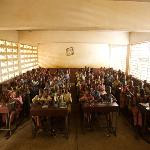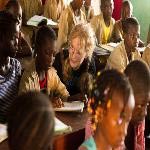
Ten-year-old Adama Sow shares her two-person desk with three other girls at Dixin Elementary school in Conakry. There are 80 students in her class, typical for this urban school.
The classroom is hot, Adama says. With four of us in a desk, it is too cramped to write. She says there are too many students, and the classroom is small.
Teacher, Fatimata Camara, said the tight quarters make it difficult for students to concentrate.
She says it is difficult to teach 85 children at once and make sure they each understand the lesson. But these are important years, she says, when children are learning to read and write. Correcting the homework of so many students is also overwhelming, and she says 30 would be a more manageable class size.
Once Camara's morning shift of students goes home at lunch time, as many as 85 more students will come for afternoon classes. There are an average of 150 students to each teacher at Dixin Elementary.
But U.N. Children's Fund's representative to Guinea Julien Harneis says UNICEF is just as concerned about the growing numbers of children who are not in these crowded classrooms.
"There has been a lack of investment in the education sector in this country for several years now, and so as a result, the percentage of children who go to school has dropped over the last two years, which is very unusual for anywhere in the world and is particularly unusual for this country, which has had rising education for the last 20 years," he said.
He said the political crisis that has racked Guinea since 2008 has blocked funding and stalled much-needed reform to the education sector.
"It is not that the children do not want to come," he added. "It is not that the parents do not want to send their children to school. It is that there is not enough classrooms. There is not enough classrooms, there is not enough benches for kids to sit on. There is not enough teachers to train them."
At Dixin Elementary, three classrooms sit empty. Their roof blew off in a storm in 2006 and has yet to be replaced. There are no desks and chairs for another classroom so it sits unused as well. There are no bathrooms, cafeteria or clean drinking water for students.
But there are signs of hope. Last week in Washington, D.C., the Catalytic Fund of the international Fast Track Initiative "Education for All" campaign, managed by the World Bank, approved the disbursement of $64 million to Guinea.
Of that money, $24 million will be managed by UNICEF, during a two-year period, to build as many as 1,000 classrooms, train teachers and improve curriculum in Guinea.
Visiting Dixin Elementary last week, UNICEF Goodwill Ambassador and celebrated American actress, Mia Farrow, crouched in the crowded rows of students to listen to them read.

"I sense that I am seeing the best this morning, and the best is not good enough for the kids," said Farrow. "I understand that this is a time of transition, so money is scarce, but it is tragic when a scarcity of funds is taken out on the children, who are, of course, the future of Guinea."
The school was one of Farrow's first stops on a five-day visit to highlight the education and health-care needs of Guinea's children before next month's presidential poll.
cramped: not spacious enought(狭窄的)
disbursement: 支付款
'Non-Formal' schools aim to fill need in Kenya's slums
Three schools for the learning disabled
Mali women push for girls education
Rural Sierra Leone needs trained teachers
(来源:VOA 编辑:陈丹妮)
